Companion@360 → 7 Month programme to sharpen your writing skills → REGISTER NOW
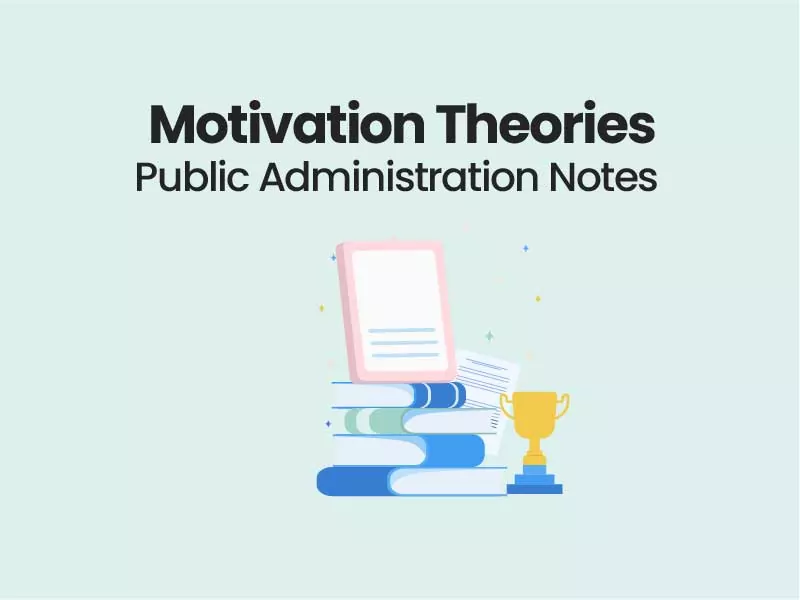
Motivation Theories – Content, Process and Contemporary
Meaning of Motivation
Motivation refers to an individual’s drive towards the desired goal with persistence, direction and intensity.
Motivation has been defined by Michael J. Jucius as : ‘‘the act of stimulating someone or oneself to get a desired course of action, to push the right button to get a desired reaction.’’
Nature Of Motivation
1.Motivation is a personal and internal feeling. It is a psychological phenomenon which generates within an individual.
2.Motivation is a behavioral concept that directs human behavior towards certain goals.
3.Motivation is a continuous process.
4.Motivation can be either positive or negative.
5.Motivation is different from job satisfaction.
6.Motivation is an integral part of the management process and every manager must motivate his subordinates to create in them the will to work.
Significance Of Motivation
Motivation is one of the most crucial factors that determine the efficiency and effectiveness of an organization. High motivation provides the following advantages
1.Motivated employees give greater performance than demotivated ones.
2.Motivation inspires employees to make best possible use of different factors of production.
3.Higher motivation leads to job satisfaction of workers. As a result labor absenteeism and turnover are low.
4.Motivational schemes create integration of individual interests with organizational objectives
Types Of Motivation
Mainly 2 types of motivation- Positive & Negative.
Positive or Incentive Motivation:
Positive motivation is generally based on reward.
According to Flippo, ‘‘Positive motivation is a process of attempting to influence others to do your will through the possibility of gain or reward.’’ People work for incentives in the form of the four Ps of motivation : praise, prestige, promotion and pay cheque.
• Negative or Fear Motivation:
• Negative motivation is based on force and fear. Fear causes people to work in a certain way because they are afraid of the consequences if they don’t. If workers do not work, they are threatened with lay off or demotion.
Negative motivation has certain limitations.
Imposition of punishment frequently results in frustration among those punished, leading to the development of maladaptive behavior. Punishment also creates a hostile state of mind and an unfavorable attitude to the job.
- Moreover, it may result in lower productivity because it tends to dissipate such human assets as loyalty, cooperation and esprit de corps.
- Inspite of these demerits, negative motivation has been used to achieve the desired behavior.
However, in recent years, the trend has been towards the use of positive motivation.
Theories Of Motivation
Some of the traditional theories of motivation are :.
- Fear and Punishment Theory:
- This theory involves the use of coercion and threat,close supervision and tight control of behavior.
- The basic idea behind this theory is that people work for the sake of money and that they will work only to ensure that the job is not lost.
- The Theory was authoritarian and military in tone and individuals had no option but either to ‘toe the line or leave the job’.
- In the present circumstances, this theory is unsuitable.
- Reward Theory:
- This theory involves the offer of some reward and good working conditions to motivate people to work better and harder; their demands are satisfied and harmony achieved.
- It is based on the assumption that people are motivated to work to the extent to which they are rewarded.
- Frederick Taylor is said to be the originator of this theory as he said, ‘‘Give a man more money and he will produce more.’’ However, sometimes satisfaction leads to indifferent performance.
- Peter Drucker says, ‘‘Satisfaction with monetary rewards is not a sufficient motivation.’’
- Carrot and Stick Theory :
- This theory assumes that people can be motivated to work if rewards are offered or withheld.
- The rewards are attached to, and made contingent upon,effective performance.
- Persons are rewarded for special accomplishments but are penalized if their performance falls below some minimal level.
Modern theories of Motivation are:
Maslow’s Hierarchy of Needs:
- A person’s motivational needs can be arranged in a hierarchical manner. Maslow identified five levels in his need hierarchy.They are,in brief, the following.
- Physiological needs: Physiological needs may be synonymous with the biological needs of human beings like hunger, thirst, sleep andsex, etc. These are the basic needs for sustaining human life itself.
- Safety needs : This second level of needs is roughly equivalent to the security needs.Maslow stressed emotional as well as physical safety. These are needed to be free of physical danger and of the fear of losing a job, property, food or shelter.
- Social needs: As man is a social animal, hence once his physiological and safety needs are fulfilled, he seeks affection, love and belongingness from other human beings. These desires motivate their behavior consciously or unconsciously.
- Esteem needs: The esteem level represents the higher needs of human beings.The needs of power, achievement and status can be considered to be part of this level. Maslowcarefully pointed out that the esteem level contains both self esteem and esteem from others
- Self-actualisation : Maslow regards this as the highest need in his hierarchy.It is the desire to become what one is capable of becoming—to maximize one’s potential and to accomplish something. The desire for self fulfillment, actualisation and leaving a meaningful life is reflected in this need.
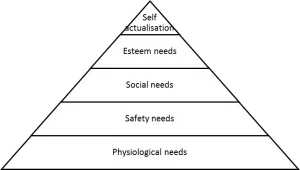
- Maslow further suggests that these levels are interdependent and overlapping. Each higher need level emerges before the lower needs have been completely satisfied.i.e, only one particular need is predominant which is known as prepotent need. It excludes the influence of other needs.The hierarchy of needs is not always fixed.
Join Telegram Channel for Public Administration
Telegram Channel dedicated entirely for public administration. It will help you in connecting current affairs, writing answers and getting 300+ in Public Administration

Evaluation of Maslow’s Hierarchy of needs
- Maslow’s theory of need hierarchy has had a tremendous impact on modern management approaches to motivation.
- His theory of need hierarchy was criticized mainly on the
- Grounds of sophistication
- There is not a single word about cultural difference in the theory, whereas culture difference matters a lot.
- When analyzing the theory on a significant country basis, the cultural differences can be found easily. For example, there are different needs of individuals across China that vary a lot from Maslow’s needs theory.
- Validity of his research data
- Maslow formulated the characteristics of self-actualized individuals from undertaking a qualitative method called biographical analysis.
- It could be argued that biographical analysis as a method is extremely subjective as it is based entirely on the opinion of the researcher. Personal opinion is always prone to bias, which reduces the validity of any data obtained.
- Therefore Maslow’s operational definition of self-actualization must not be blindly accepted as scientific fact.
- The order of hierarchy of needs.
- The theory gives an oversimplification of human needs and motivation. Need recognition and fulfillment don’t always follow the specific sequence or hierarchy suggested by Maslow. The hierarchy of needs is not always fixed. Different people may have different orders. There is no definite evidence that once a need is satisfied it loses its motivating force.
- Many creative people, such as authors and artists lived in poverty throughout their lifetime, yet it could be argued that they achieved self-actualization.
- Another example of Mahatma Gandhi is one of the most important. There are always some people in whom the need for self esteem is more prominent than social needs.
- It is also doubtful that satisfaction of one need automatically activates the next need in the hierarchy. Some persons will not aspire after their lower order needs have been satisfied.
- Despite these limitations, Maslow’s theory provides a convenient conceptual framework for the study of motivation.
- This theory is very simple, common and easily understandable.
- It accounts for both interpersonal and intra-personal variations in human behavior.
- This theory is dynamic because it presents motivation as a changing force; changing from one level of needs to another level.
McGregor’s Theory ‘X’ and Theory ‘Y’
- McGregor has developed a theory of motivation on the basis of hypotheses relating to human behavior.
- According to him, the function of motivating people involves certain assumptions about human nature. Theory X and Y are two sets of assumptions about the nature of people.

- THEORY X:
- The traditional assumptions about the nature of people, according to McGregor, are included in Theory X as follows
- Average human beings have an inherent dislike of work and will avoid it if they can
- Because of this human characteristic of disliking work, most people must be coerced,controlled, directed, and threatened with punishment to get them to put forth adequate effort toward the achievement of organisational objectives
- Average human beings prefer to be directed, wish to avoid responsibility, have relatively little ambition, and want security above all
- On the basis of these assumptions workers have to be persuaded and pushed into performance.
- External control is considered appropriate for dealing with unreliable,irresponsible and immature people.
- According to McGregor, an organisation built upon Theory ‘X’ notions will be one in which there is close supervision and control of subordinates and high centralisation of authority.
- Leadership in such organisations will tend to be autocratic,and workers will have very little say in decisions affecting them. The climate in Theory X organisation would be impersonal—this theory implies use of ‘Carrot and Stick Approach’.
- THEORY Y
- He propounded Theory Y which, he said, would better represent human behaviour.
- The expenditure of physical effort and mental effort in work is as natural as play or rest
- External control and the threat of punishment are not the only means for producing effort toward organisational objectives. People will exercise self direction and self control in the service of objectives to which they are committed.
- The degree of commitment to objectives is in proportion to the size of the rewards associated with their achievement.
- Average human beings learn, under proper conditions, not only to accept responsibility but also to seek it
- The central principle implicit in the assumptions of Theory Y is that integration of behaviours is the key process in management, because it results in the creation of conditions conducive for the members to achieve their own goals best by directing their efforts towards the success of the enterprise.
Evaluation of McGregor’s Theory X & Y
- While considering the merits if the theory,
- Theory ‘X’ and theory ‘Y’ are a good guide to management, to not only developing motivational techniques; but also attuning entire managerial systems around these assumptions about human behaviour.
- McGregor’s assumptions about human behaviour are rather realistic; as in practice we usually find people corresponding to Theory ‘X’ or Theory ‘ Y’ ideologies.
- But there are many demerits as well like
- McGregor has just stated his assumptions about human behaviour. These could not be called a reality; till these assumptions are put to testing or experimentation.
- Attuning management practises according to Theory X assumptions makes for a hard approach to managing; and invites resistance of people to management practises. Likewise, attuning management practises according to Theory Y assumptions makes for a soft approach to managing and leads to laissez faire management and organizational inefficiencies.
- Theory ‘X’ and Theory ‘Y’ assumptions are two extreme sets of assumptions about human behavior. In fact, there are very few persons who exactly correspond with Theory ‘X’ or Theory ‘Y’ assumptions. Most of the people may fall in between these two extremes of human behavior. McGregor has ignored this aspect of human behavior.
- Since human behavior is quite variable; the same person may, at times, behave according to Theory ‘X’ assumptions; and at times, according to Theory ‘Y’ assumptions. This phenomenon of variable human behavior is overlooked by McGregor.
- Every enterprise has a mix of Theory X and Theory Y people. There is a problem for management to evolve universal management techniques towards effective management throughout the enterprise, as a whole.
- For McGregor, Theory X and Theory Y are not opposite ends of the same continuum, but rather two different continua in themselves. In order to achieve the most efficient production, a combination of both theories may be appropriate. This approach is derived from Fred Fiedler’s research over various leadership styles known as the contingency theory.
Theory of Herzberg
- Herzberg’s contribution include
- Two factor Theory or Hygiene & Motivation Theory
- Job Enrichment
- Frederick Herzberg researched purposes to find a Two-factor Theory of motivation and believed that motivation is multidimensional in relation with goal.
- To him, individuals have two sets of needs. First to avoid pain and second is to grow psychologically, which is known by motivation-hygiene theory.
- In his theory he identified two factors- Disatisfiers & Satisfiers.
| HYGIENE FACTORS(Dissatisfiers) | MOTIVATION(Satisfiers) |
| Organization policy and Administration, Supervision, Working Conditions, Interpersonal relations, Salary, Status, Job security and Personal life. | Achievement, Recognition, Challenging work, Advancement and Growth in the job. |
| They are deficit factors & extrinsic | They are intrinsic factors |
| They are finite and limited | They are infinite and referred as growth factors |
| They are only dissatisfiers and not motivators. | They are found to be the real motivators |
- He observed that both factors have their distinct impacts.Though dissatisfiers are critical for elimination of dissatisfaction, the individuals motivation grows from satisfiers
- .He came up with ‘Dual Unipolar Trait Theory’ which advocated that the satisfiers and dissatisfiers are not two extremes of one continuum rather they belonged to different continuums
- Herzberg identified two types of workmen namely hygiene and motivation seekers. It is the responsibility of the manager to first identify the nature of the workers in the organisation.Once identified s/he should work on both the factors accordingly.

- It is easier to motivate the hygiene seekers through the fear of hygiene deprivation than to motivate in terms of achievement and actualisation of goals. However in the long run this policy has an injurious impact on the organization . Therefore Herzberg also discussed job enrichment.
- The routine and repetitive work lead to a monotonous lifestyle which may be stressful and result in boredom. This may be handled through job enrichment.
- It is a technique used by company managers to maximize an individual’s internal motivation to work, which is the true source of job satisfaction.With it, people felt motivated if the job was interesting and challenging; if the possibilities of growth existed in it; if they were able to obtain a sense of achievement; if they had the responsibility and authority to use their discretion; and they were able to advance in the profession and receive recognition for the tasks they did.
- He negated the horizontal loading of Chris Argyris and promoted vertical loading. Instead of doing the same kind of job, the individual should rather multitask his job and have more responsibilities through vertical loading.
Evaluation of Herzberg’s Theory
- Herzberg’s contribution to work motivation is substantial as he focussed attention on the significance of job content in motivation which was a neglected factor earlier.
- However, much controversy still surrounds the theory. Its research methodology and propositions have been widely questioned by critics. The points of criticism are as follows :
- The original research evidence has a narrow base, confined only to 200 accountants and engineers who were relatively well-paid. It was not proper to make theoretical generalizations from such an unrepresentative sample.
- Job context and job content factors cannot be neatly separated.The former in some cases, may generate positive motivation, satisfaction and higher performance while the latter in some cases, may totally fail to do so.
- The theory focuses on job satisfaction and dissatisfaction and considers that they cause good or bad job performance, as the case may be. But there need not be any cause-effect relationship between satisfaction and performance
- No comprehensive measure of satisfaction was used. An employee may find his job acceptable despite the fact that he may hate part of his job.
- Another criticism is that Herzberg’s theory conflates satisfaction and productivity. While it might be true that being more satisfied can make you work harder, Herzberg only investigated satisfaction levels, not work output.
- There is also some controversy whether or not the theory applies to all professions. A 1996 study by Joseph Gawel showed that the theory did not hold up for teachers: schools were losing teachers to higher-paying jobs, which suggested salary acts as a motivator.
Some of the contemporary theories which reflects the modern concepts on motivation are :
ERG Theory
- Clayton Alderfer reworked on Maslow’s Need Hierarchy to realign it more closely with the empirical research and labeled it as ERG Theory.
- ERG Theory believed that individuals have multiple deficits and these deficits are the reasons for motivation. There are three groups of core needs-
- E – Need for existencewhich includes physiological and security.
- R – Need for relatednesswhich includes social and extrinsic components of esteem needs.
- G – Need for growth which includes intrinsic components of esteem need and self actualisation.
- The novelty of ERG Theory is that more than one need may be prepotent at the same time and there is no definite sequence for the dominance of needs.
- If the higher order needs of individuals are not satisfied then the desire to satisfy the lower order needs increases. This is referred to asFrustration- Regression by Alderfer. The frustration of the higher order needs can lead to regression to a lower order needs.
- ERG Theory is more consistent with knowledge of individual differences among the people. There may be many factors such as education, family, and cultural environment which influences the need for a particular individual.Therefore managers should try to identify the needs of the individual.
McClelland’s Theory of Needs
- It is similar to Theory of needs by Maslow and Alderfer.
- The theory is based on multiple needs for motivation and known as Achievement -Motivation
- It focused on 3 major needs-
- Need for Achievement- (nAch)The drive to excel, to achieve in relation to a set of standards thereby seeking personal responsibility for accomplishing a job.
- Need for Power-(nPow) The need to make others behave in a way that they would not have otherwise behaved i.e, to control others.
- Need for Affiliation-(nAff)The desire for friendly, relaxed and close interpersonal relationships.
- Every individual will have different degrees of all the three needs.
- Managers should suitably use individuals based on the 3 needs like
- High nAch individuals should be allocated with jobs accepted by them, that allow autonomy and provide feedback and have moderate risk.
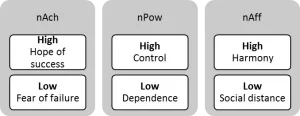
The managers with high nPow and low nAff are generally successful from the point of manager’s need, not from workers.
Goal Setting Theory
- Proposed by Edwin Locke where he observed that specific and difficult goals with provision for feedback lead to high performance.
- Goal setting involves the development of an action plan designed in order to motivate and guide a person or group toward a goal
- Goals are more deliberate than desires and momentary intentions. Therefore, setting goals means that a person has committed thought, emotion, and behavior towards attaining the goal.
- He indicated three moderators that indicate goal setting success
- Setting goals can affect outcomes in four ways:
- Choice: Goals may narrow someone’s attention and direct their efforts toward goal-relevant activities and away from goal-irrelevant actions.
- Effort: Goals may make someone more effortful. For example, if someone usually produces 4 widgets per hour but wants to produce 6 widgets per hour, then they may work harder to produce more widgets than without that goal.
- Persistence: Goals may make someone more willing to work through setbacks.
- Cognition: Goals may cause someone to develop and change their behavior.
Reinforcement Theory
- It is an extension of goal setting theory.
- The theory advocated that behaviour is a function of its consequences.
- Goal setting theory observed that the perception of an individual emerges from within or oneself
- Reinforcement theory contradicted the view and observed that the perception itself is a byproduct of positive reinforcement of others.
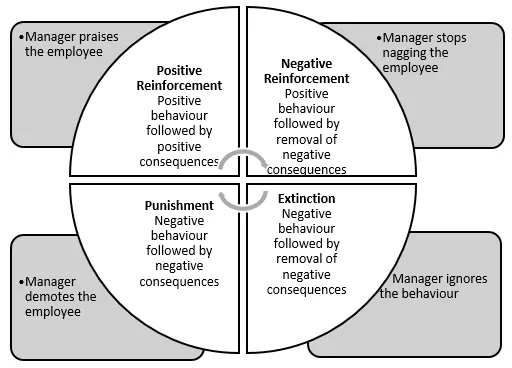
Cognitive Evaluation Theory (CET)
- CET observed that the allocation or introduction of extrinsic rewards for the behavior that had been intrinsically rewarding tends to decrease the overall level of motivation.
- The impact of intrinsic, extrinsic factors and interrelationship of both over individual performance are observed .
- It is similar to Herzberg’s two Factor theory.
- However, the theory explained those phenomena which Herzberg’s theory failed to do. For instance, Herzberg could not explain why when a person is recruited as a permanent employee from being voluntary loses enthusiasm and zeal. The excitement of voluntary work was a new task, sense of work and importance etc. But when pay and supervision which are extrinsic factors come into play, the perception of an individual changes from being a controller to performer.
- Therefore the introduction of extrinsic factors weakened the influence of intrinsics.
- It was found that though intrinsic factors motivate an individual the extrinsic factors are also motivational for particular jobs.
- The extrinsic factors may become intrinsic factors at a low level of organizations.
- The people with more intrinsic factors are more successful at higher levels of organisation.This is because at higher levels the job itself is motivating..Therefore at higher levels the motivation seekers who are tolerant to extrinsic value should be placed.
Job Design Theory
- Maslow, McGregor and Herzberg had touched upon the importance of looking at work itself as a possible source of motivation. However, it failed to come with substantial concepts.
- It was Job design Theory that came up with stronger evidence to suggest that the way elements in a job are organized can act as a source of motivation.
- The characteristics of a job could influence the perception of an individual and that perception defines the performance of the individual.
- It explained the basis of motivation through the JobCharacteristics Model (JCM).
- According to JCM a job can be described in 5 core dimensions.
- Skill Variety- Degree to which the job required a variety of different skills of workers.
- Task Identity-Degree to which the job required the completion of a whole and identifiable piece of work.
- Task Significance – Degree to which the job has substantial impact on other people.
- Autonomy -Degree to which the job provides substantial freedom and discretion
- Feedback
- JCM grouped these 5 dimensions into 3 psychological states/perceptions.
| Dimensions | Psychological states/Perceptions |
| Skill Variety | Experience of meaningfulness of work |
| Task Identity | |
| Task Significance | |
| Autonomy | Experience responsibility for the outcomes of work |
| Feedback | Knowledge of the actual results of the work activities. |
- The core dimensions can be combined into a single predictive index called Motivational Potential Scheme(MPs)
MPS= (Skill Variety+Task Identity+Task structure)/3*Autonomy*feedback
- The jobs will have high motivational potential when at least one of the three factors of experience of meaningfulness is high and both autonomy and feedback are high.If the jobs have high MPS then it indicates high motivation, performance and satisfaction and vice versa.
Equity Theory
- Propounded by J Stacy Adam.This theory is maturation of theory of motivation by Herbert Simon & Barnard.
- The individuals compare their job inputs and outcomes with those of others and they respond to eliminate any inequities.
- According to the theory, the individual enters into an organization to contribute but the contribution is contingent with satisfaction.i.e, relation between contribution and satisfaction.
- If the contribution is equivalent to satisfaction then there is equity.
- There are four referent comparisons that an employee can use –
- Self Inside: The individual compares with the different position inside his/her current organization.
- Self Outside: The individual compares with the different positions outside his/her current organization.
- Other Inside: The individual compares with another individual or group of individuals inside the employees organization assuming that the other individual had occupied his or her position.
- Other outside: The individual compares with another individual or group of individuals outside the employees organization assuming that the other individual had occupied his or her position.
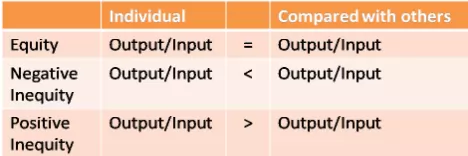
- There are 2 situations for lack of motivation – Positive(Over reward) and negative(under reward) equity.
- Incase of overreward, the individual develops a sense of guilt whereas under reward develops a sense of betrayal and stress.
- In both the cases the individual regresses to equity through –
- Changing the Input
- Changing the Output
- Distort perception of self
- Distort the perception of others
- Choose a different referent
- Leave the field.
Expectancy Theory by Victor Vroom
- He holds that people will be motivated to do things to reach a goal if they believe in the worth of that goal and if they can see that what they do will help them in achieving it. I.e, goal attractiveness & Perception of attainability of personal goal.
- Vroom’s theory is that people’s motivation toward doing anything will be determined by the value they place on the outcome of their effort, multiplied by the confidence they have that their efforts will materially aid in achieving a goal.
- In other words, Vroom makes the point that motivation is a product of the anticipated worth that an individual places on a goal and the chance he or she sees of achieving that goal.
- Vroom’s model is built around the concept of valence, expectancy and force. Vroom’s concept of force is equivalent to motivation and is again equivalent to the product of valence and expectancy.
- In his own terms, Vroom’s theory may be stated as :
Force = Valence × Expectancy
Where force is the strength of a person’s motivation, valence is the strength of an individual’s preference for an outcome, and expectancy is the probability that a particular action will lead to a desired outcome.
- The theory explained the basis for motivation through 4 important factors that are capsule into three important equations.
- The 4 factors are efforts, performance, rewards and personal goals. And the three equations are effort-performance, performance-reward and reward-personal goals relationship.
- According to his theory people get motivated when all the 3 equations are positive.
- However, the theory has been criticized on the following grounds :
- The theory is not empirically tested. It is complex and its validity cannot be fully tested.There are only a few research studies designed to test the theory.
- The theory cannot be applied in practice. From a theoretical standpoint, the model seems to be a step in the right direction but it does not give the manager practical help in solving motivation problems.

- There are so many technical and methodological problems to do research on the theory. Valence cannot be measured on ratio scales, each valence is explained in the terms of all other valances.
